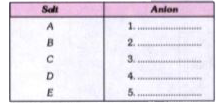The gas which turns mercurous nitrate paper black is
The correct Answer is:a
To solve the question "The gas which turns mercurous nitrate paper black is:", we can follow these steps:
1. Identify the Given Options:
The options provided are:
- A) NH3 (Ammonia)
- B) Cl3 (Chlorine)
- C) SO2 (Sulfur Dioxide)
- D) SO3 (Sulfur Trioxide)
2. Understand the Reaction:
We need to determine which of these gases can react with mercurous nitrate (Hg2(NO3)2) to produce a black color. Mercurous nitrate paper is used to test for the presence of certain gases.
3. Analyze Each Gas:
- NH3 (Ammonia): When ammonia gas reacts with mercurous nitrate, it forms mercury (Hg) and ammonium nitrate (NH4NO3), along with an insoluble complex of HgNH2NO3. The finely divided mercury produced is what turns the paper black.
- Cl3 (Chlorine): Chlorine does not react with mercurous nitrate to produce a black color.
- SO2 (Sulfur Dioxide): Sulfur dioxide does not produce a black color when reacting with mercurous nitrate.
- SO3 (Sulfur Trioxide): Sulfur trioxide also does not react to produce a black color.
4. Conclusion:
Based on the analysis, the gas that turns mercurous nitrate paper black is NH3 (Ammonia). Therefore, the correct answer is option A.
Final Answer:
The gas which turns mercurous nitrate paper black is NH3 (Ammonia).
---
The options provided are:
- A) NH3 (Ammonia)
- B) Cl3 (Chlorine)
- C) SO2 (Sulfur Dioxide)
- D) SO3 (Sulfur Trioxide)
We need to determine which of these gases can react with mercurous nitrate (Hg2(NO3)2) to produce a black color. Mercurous nitrate paper is used to test for the presence of certain gases.
- NH3 (Ammonia): When ammonia gas reacts with mercurous nitrate, it forms mercury (Hg) and ammonium nitrate (NH4NO3), along with an insoluble complex of HgNH2NO3. The finely divided mercury produced is what turns the paper black.
- Cl3 (Chlorine): Chlorine does not react with mercurous nitrate to produce a black color.
- SO2 (Sulfur Dioxide): Sulfur dioxide does not produce a black color when reacting with mercurous nitrate.
- SO3 (Sulfur Trioxide): Sulfur trioxide also does not react to produce a black color.
Based on the analysis, the gas that turns mercurous nitrate paper black is NH3 (Ammonia). Therefore, the correct answer is option A.
The gas which turns mercurous nitrate paper black is NH3 (Ammonia).
Topper's Solved these Questions
- QUALITATIVE INORGANIC SALT ANALYSISBOOK - CENGAGE CHEMISTRY ENGLISHCHAPTER - QUALITATIVE INORGANIC SALT ANALYSISEXERCISE - Viva Voce Questions And Part-A (Analysis Of Anions)
30 Videos
- QUALITATIVE INORGANIC SALT ANALYSISBOOK - CENGAGE CHEMISTRY ENGLISHCHAPTER - QUALITATIVE INORGANIC SALT ANALYSISEXERCISE - Viva Voce Questions And Part-B (Dry Tests)
9 Videos
- QUALITATIVE INORGANIC SALT ANALYSISBOOK - CENGAGE CHEMISTRY ENGLISHCHAPTER - QUALITATIVE INORGANIC SALT ANALYSISEXERCISE - Ex 8.1
14 Videos
- P-BLOCK GROUP 18 ELEMENTS - THE INERT GASESBOOK - CENGAGE CHEMISTRY ENGLISHCHAPTER - P-BLOCK GROUP 18 ELEMENTS - THE INERT GASESEXERCISE - Ex 5.1 (Objective)
14 Videos
- REDUCTION AND OXIDATION REACTION OF ORGANIC COMPOUNDSBOOK - CENGAGE CHEMISTRY ENGLISHCHAPTER - REDUCTION AND OXIDATION REACTION OF ORGANIC COMPOUNDSEXERCISE - SUBJECTIVE TYPE
4 Videos
Similar Questions
A gas which turns lead acetate paper black.
View SolutionSalts A, B, C, D and E undergo reactions (i) to (v) respectively. Identify the anion present in these salts on the basis of these reactions. Tabulate your answers in the format given below:
(i) When silver nitrate solution is added to a solution of A, a white precipitate, insoluble in dilute nitric acid, is formed.
(ii) Addition of dilute hydrochloric acid to B produces a gas which turns lead acetate paper black.
(iii) When a freshly prepared solution of ferrous sulphate is added to a solution of C and concentrated sulphuric acid is gently poured from the side of the test-tube, a brown ring is formed.
(iv) When dilute sulphuric acid is added to D a gas is produced which turns acidified potassium dichromate solution from orange to green.
(v) Addition of dilute hydrochloric acid to E produces an effervescence. The gas produced turns lime water milky but does not affect acidified potassium dichromate solution.

View SolutionGreenish yellow gas which turns starch iodide paper black.
View SolutionIdentify the salt R from the observation
Salt R is black in colour. On reacting with concentrated HCl, it liberates a pungent greenish yellow gas which turns moist starch iodide paper blue black.
View SolutionTwo inorganic compounds A and B were heated in a dry test tube. A evolved a colourless gas which turned lead acetate paper black and B evolved a gas which turned lime water milky. The anions in A and B respectively are :
View SolutionName the gas that turns moist starch iodide paper blue black.
View SolutionName the gas that
turns moist starch iodide paper blue black.
View SolutionState the inference drawn from the following observations:
A gas Q turns moist lead acetate paper silvery black. Identify the gas Q.
View SolutionState the inference drawn from the following observations :
A gas Q turns moist lead acetate paper silvery black. Identify the gas Q.
View SolutionState the inference drawn from the following observation:
A gas Q turns moist lead acetate paper silvery black. Identify the gas Q.
View Solution
